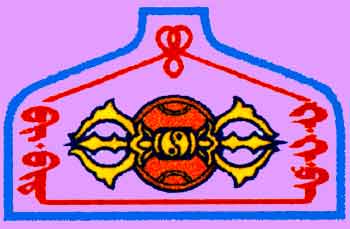|
- Catalog (in stock)
- Back-Catalog
- Mail Order
- Online Order
- Sounds
- Instruments
- Projects
- History Face
- ten years 87-97
- Review Face
- our friends
- Albis Face
- Albis - Photos
- Albis Work
- Links
- Home
- Contact
- Profil YouTube
- Overton Network
P & C December 1998
- Face Music / Albi
- last update 02.2023
|


art studio - Bi-Bid
|
art studio "Bi-Bid" - Mongolia
- founded in 1997 -
Presentation of artwork and handicraft made by the workshops
of young artists in Mongolia.
Manufacture and sale Mongolian artwork and handicraft.
- original painting with watercolors - antique thangkas - sculptures - dolls (toys) - dance masks of Buddhists
("tsam"-masks in papier-màché) - quality ritual objects of Buddhists.
Organization of art exhibitions and cultural events
with music and dance.
Contact: Mongolian artwork:
Gankhuyag Natsag - hompage mn

Ganna and Albi
|
|
Text in German
- A short introduction on artwork and handicraft
| - These include traditional pictures of the artwork made by craftsmen; traditional style of painting, form of ceramics or metal (silver, copper, bronze or brass), carving of wood or stone (with soft materials). |
| - Masterworks in what we can describe as an aspiration for explicit decorativeness to the tradition of everydays life. They are all deeply rooted in and closely associated with the national ornaments created under the conditions of nomadic life. They express not only the national originality but rather the aesthetical values of the nomadic people. Another feature of this form of handicraft lies in the fact that nearly everything is created from materials which have been used by man for centuries, such as ceramics, metal, wood, stone, skin, and wool. |
| - One of the main types of applied artwork is the artistic treatment of metals. The nomadic people has been developing this handicraft from time immemorial on, and it was facilitated by the many riches of the form of casts, coinage, engraving, gilding, incision of silver on iron, grinding, stamping and other technical methods widely used by the blacksmith-masters. Precious metals and semi-precious stones are used for jeweller's work, which are then decorated with filigree, i.e. intricate and interknitted national pattern from silver thread with complicated relief design. The coinage artcraft is widely practised, with works of art made from copper and brass with certain parts gilded. The treatment of steel with ornamented carving is revived. |
| - Various methods of treatment of wood have been known by the masters for a long time. They master the techniques of flat relief and round sculptures. Refined sense of materials, proportionality of ratio, and habits of rhythmical articulations of ornamented flatness have been developed over many centuries. Predominance of animalistic motives and thorough knowledge of animal habits are the main feature of wood sculpture. The national wooden toy is a jolly and lovely toy inspired with special affection, sincerity, and gentle joke. |
| - Mongolian chess comprehends a number of unique characters. It differs from European chess not only by the rules but also the shape of its figurines. Every single figurine, which is not bigger than 5 cm, reflects the life of a cattle-breeder and shows rich imagnation and fantasy. |
| - Handicraft, made from skin, thick felt, and textile is also popular among the people. This is explained not only by the fact that the necessary raw materials for making them were ready at hand but by the fact that handicraft, made from soft materials, was easily portable, reliable, durable and compostable. Protuberant salient design, obtained by techniques of stamping, plays an important role for the treatment of skin. Patterned embroidery with wool and silk cord is the distinctive kind of decoration of skins. |
| - Embroideries are usually made in chain-stitch. Embroiderers use silk and wool thread, which creates a clear picture in the decorated surface. Embroideries which are unique in its form and scenery of composition are a nice addition to clothes and the interior. |
| - Stone is a favourite material of Mongolian craftsmen: Exceptionally many memorials of our ancestors represent the classical example of nomad art. The variety of forms and the stylistic manner of fulfilment have been handed down to the present masters. The diminutive motif and the plasiticity of sculptures wonderfully and positively transmit the disposition of a depicted art ware. Good knowledge of animal anatomy allows the craftsmen to create figures of fast horses and leaders in herd. The main werit lies in the ability of a master to express, by means of small plastics, the monumentality of the whole image and form. The production of ceramics constitutes the oldest form. |
| - Aside from bronze, ceramics occupied an important place in the life of our ancestors. Numerous examples of small plastics by modern artists keep the tradition of harmony, given by a laconic form, alive. |
- The century-old popular art tradition was responsible for the development of a national painting style which is known as Mongol zurag. Zurag style, characterized by conditionality of landscape, drawing of contours, absence of chiaroscuro, jeweller's treatment of not only the main but also of minor details of a painting in which every detail forms an independent element of narration.
- Colour-symbolics was given to this national painting style from popular art. It is known that Mongolians love especially the colours blue (symbol of stability), green (symbol of everlasting life), white (symbol of nobility, of reflection and feeling), red (symbol of joy), and yellow (symbol of love).
- Restraint and accuracy of colour availability, apart from ornamental motives of age-old canons for conditional portrayal of curves of clouds, waves, flames, wind, mountains and rocks, in the style of zurag, essentially differ from other schools. Furthermore, painters usually work on the canvas with specially prepared paints which are reminiscent of the distemper of gouache.
|
- From what is mentioned above, it is possible to distinguish features common in all these styles of the decorative applied art. They include realism in presentation, the painters' strife to image completeness and form perfection as well as mastership in performance characterised by dynamism. Much attention is paid to ornament. The ornament is based on the combination of nature motives and geometric ones. With the combination of colours one can express wishes for good luck, well-being, happiness and longe life.
- see more about Ornaments of the Turkic-Mongolian tribe (cloths, ceramics, handbags, tools etc.)
- see more about Ornaments of the Yakuts
©Albi - Face Music - February 2006 – English revised by Hermelinde Steiner
|
PageTop

|
